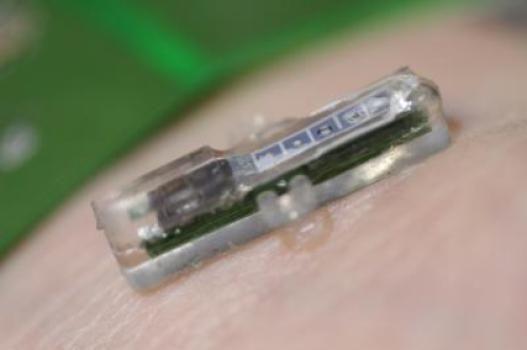Skin Implant Sends Test Results To Your Smartphone [Video]

The École polytechnique fédérale de Lausanne (EPFL or Swiss Federal Institute of Technology in Lausanne) has developed as small device that can analyze tissue levels of chemicals and proteins and send them to a smartphone or even your doctor for analysis. The hope is that the technology will give patients and doctors an up-to-date and sequential set of data when looking at lab results. Implanted just below the skin, the device can enable health care providers to monitor patients with chronic conditions.
The device is a few cubic millimeters in size and contains advanced technology consisting of five sensors, a radio transmitter and a power delivery system. Power for the device is transmitted through the skin from a battery patch so that surgery won't be necessary when the battery runs down. The implant sends the data to the patch on the skin then transmits them to a smartphone or tablet using Bluetooth and then sends it to doctors for analysis.
The device uses enzymes to test the levels of substances such as lactate, glucose or ATP which is important in monitoring ill patients.
"Potentially, we could detect just about anything," explains Dr. De Micheli. "But the enzymes have a limited lifespan, and we have to design them to last as long as possible."
The enzymes currently being tested are good for about a month and a half; that's already long enough for many applications.
"In addition, it's very easy to remove and replace the implant, since it's so small."
One hope is that the implant will lead to more personalized chemotherapy. Doctors use blood tests to approximate the tolerance patients will have for chemotherapeutic agents in cancer treatment. Getting the dosing optimal is still tricky business. Dr. De Micheli says that.
"It will allow direct and continuous monitoring based on a patients individual tolerance, and not on age and weight charts or weekly blood tests."
The device will also help diagnose and monitory heart attack patients and diabetes sufferers.
Research in developing the device brought together experts in electronics, computer scientists, doctors and biologists from the EPFL, the Istituto di Ricerca di Bellinzona, EMPA and ETHZ. This was part of a Swiss program to encourage interdisciplinary research in the environmental science and medical fields.
Researchers expect the product to be commercially available in four years.
The press release can be found here.
Published by Medicaldaily.com



























